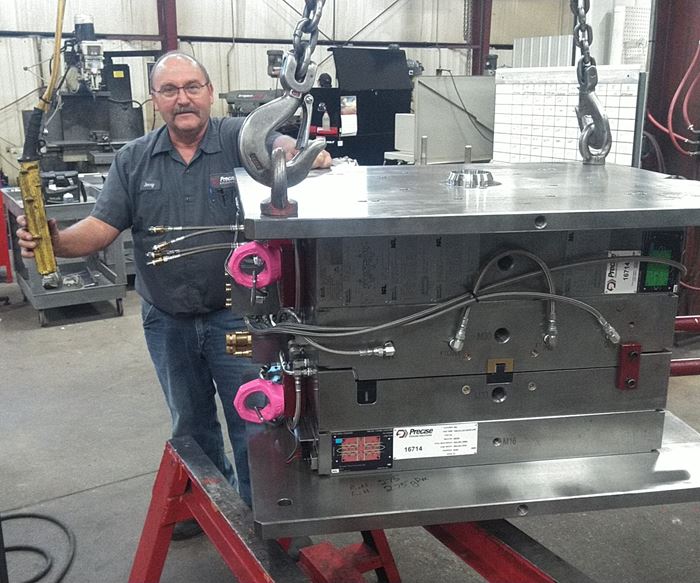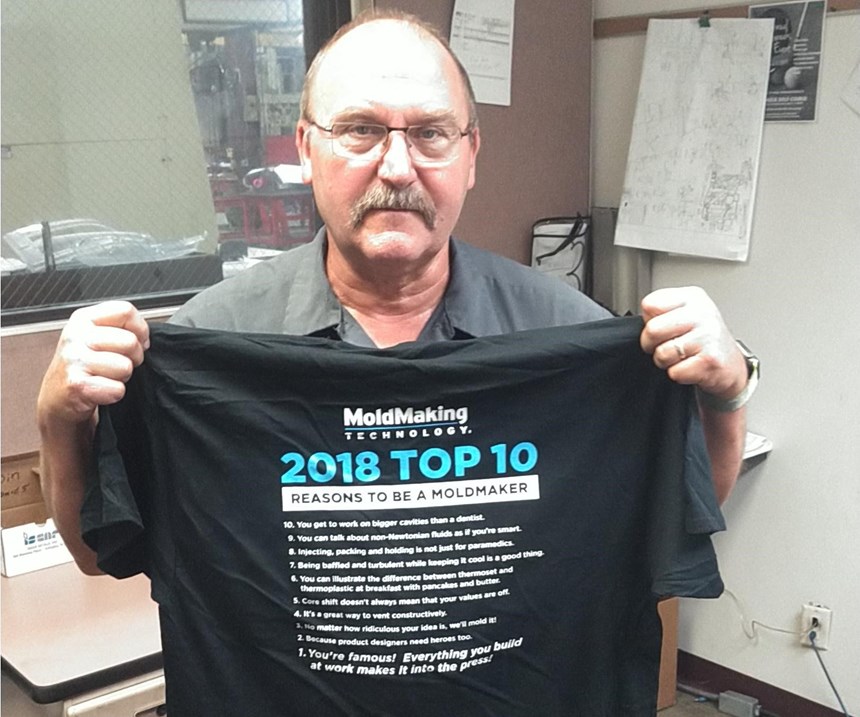Jerry Ward: Reflections on A Moldmaking Career
After dedicating 48 years to moldmaking, Jerry shares a few memories about a career he loves.
Jerry Ward is a lead moldmaker at Precise Tooling Solutions in Columbus, Indiana. This week was his last week because today, on his 66th birthday, he is retiring after 48 years in the trade. MoldMaking Technology first learned about Jerry and his impending retirement during a recent trade event. It was obvious that his employer held him in high regard, so we agreed it would be nice to interview Jerry and his family about his moldmaking career and ask him to share some of the memories he has kept.
Jerry’s wife, Susan, told me that he began his career in 1971, the Monday after his 18th birthday, at a company called Indiana Die Cast and Tool in Franklin, Indiana. I asked Jerry why he chose moldmaking for a career and he replied that it was very simple. “I was a high school junior in 1970, working at a filling station as a mechanic, and my metal shop teacher, who was a pretty good machinist himself, saw that I was good at working with my hands and could take stuff apart and put it back together,” he says. “I really got into metalworking and took his class junior and senior year. When I graduated, he called me and told me that Indiana Die Cast and Tool was looking for apprentices to become tool and die makers. I said yes, that sounds pretty cool.” Jerry went down and applied for the apprenticeship and was hired right in the door. “I started out making $2.25 an hour, which sounds crazy, but then gas was only 25 cents a gallon, bread was 10 cents and a pack of cigarettes was only about 30 cents at the time.”
I was originally certified as a tool and die maker, but I only built about two dies in my life. I was actually a moldmaker, and later I was reclassified as a moldmaker.
Jerry took a traditional four-year apprenticeship at a local community college, explaining that back then, if you didn’t have a trade you had to go to college. “I decided to go into an apprenticeship program so I would have a trade plus schooling,” he says. “I was originally certified as a tool and die maker, but I only built about two dies in my life. I was actually a moldmaker, and later I was reclassified as a moldmaker.” He recalls going to sign up to join the U.S. Air Force and getting a deferment from the military because moldmaking and die casting skills were considered critically important for national defense, plus Indiana Die Cast and Tool was working on bombs that were thrown out of helicopters. “The Air Force offered a lot of computer skills that I was interested in because technology was everything. Of course, a computer at that time would have more than filled the office we’re sitting in, and when I first got into the trade, we didn’t even have calculators. We used adding machines.”
Moldmaking Technologies
Jerry also remembers when CNC technology became available. “In the mid-70s, CNC machines were tape machines where you would have to tape G-codes in and feed them into the backs of the CNC machines. I remember thinking I could do it faster on the Bridgeport, even without readouts. You just had to be able to add and subtract and think ahead,” he says with a laugh. “You know, they just don't teach that today. You have to be able to think ahead.” Ward refers to Operations Manager Anthony Wooten, who was a protégé of Jerry’s and has joined the conversation, saying, “Anthony, you know what I am talking about. Probably 50 percent of the people we got are good at their jobs, but they don't think ahead far enough to be better.” Jerry says he has trained almost all of the young men who have apprenticed at Precise through the years, saying, “I’ve had guys come in here and they couldn’t even read a tape measure, but when they left here, they could.”
As most long-time moldmakers can attest, with the advancement of technologies for building molds came new and different approaches, including the departmentalization of the various steps taken to complete a mold build. Jerry has experienced that transformation firsthand. “That’s part of the change,” he confirms. “Some of the jobs I worked on were 20 thousand pounds, so I couldn't actually do a hands-on machine job unless I had the skills required to run that machine. Back in the day we used models and tracers, and we would trace the model and cut the metal and then we'd have to hand work, polish, blue in and try to match the wall stock. Not easy. It was very, very ‘dinosauric.’
The young people don’t know how good they have it.
“Today we go by dimensions on everything,” he continues. “Everything is digital, and it is so much cooler. I told Anthony that I love change, I just hate it when it happens because it makes my job easier. Change is really good, but it is also very hard.” He says that the last seven or eight years it has been so much easier to machine molds and make them right the first time and it can be done so much faster. “The young people don’t know how good they have it.”
A Moldmaker’s Family Life
Jerry is no stranger to a moldmaker’s hours. “We were trained to be on time, work for eight to 10 hours a day and work Saturdays, and if you had to work Sundays you didn’t complain,” he says.
“He worked six days a week, 10-1/2 hours a day almost all his career,” Susan says. “He loved his job and made many friends along the way. He provided for his family well and I was able to be a stay-at-home mom to our two boys.”
In 1978, under unusual circumstances, Jerry showed his dedication to his work. “It started out as freezing rain the night before and I backed my car into the driveway so I could get out really easy the next morning,” he says. “I had a 1974 El Camino that was pretty new and I had four or five concrete blocks in the back of it for traction. It had a 353 25-horsepower engine and it ran really good, so I made it to work, no problem.” He says he might have made it to work, but he was lucky the night shift (which comprised two men running duplicators) were still there when he arrived because he pulled into the company’s unplowed driveway and got stuck. The guys helped him dig out and he pulled the car into the shop’s bay where the others parked their cars. “I opened my hood and there were eight or 10 inches of snow all over the engine. It was a wonder it even ran.” Those cars ended up being makeshift beds for the three men over the course of two nights, he says. “I think we had about 14 inches of snowfall over a two-day period. I worked on bluing in some cams and fitting inserts and other stuff on a big job. The grinding room felt like an iceberg. We were lucky, though, because we had electricity and vending machines for food.” Eventually the men were able to get out of the shop and try to get home.
My dad always wanted us to go to college and find something that we loved doing, just like he did.
Asked if he encouraged his sons, Andy and Matt, to become moldmakers, Jerry says he felt his role as a father was to lead them to find their places. “My dad always wanted us to go to college and find something that we loved doing, just like he did,” Andy says. “So I guess he did not encourage us to go into his field, but more so encouraged us to find something that we loved doing and that could allow us to have a good life and a family just like what we had growing up.” Andy lives with his wife and son in Seattle, Washington, and is a pilot for Alaska Airlines.
Younger son, Matt, lives in Cincinnati, Ohio, with his wife and son and works as a mechanical engineer for GE Aircraft. Jerry says he is the one who more closely followed in his moldmaker footsteps. “I would come home, and he'd have something totally taken apart, laying all over the floor, and I would ask him if he was going to need help with it. He would say nope, I got it, dad, and I'd come back out there and he would be all done. He is very handy.”
In 1980, Jerry went to work at Dougherty Mold in Franklin, Indiana. Founder Dennis Dougherty was a former employee of Indiana Die Cast and Tool. In 1991, Dougherty Mold merged with Precise Mold and Plate. In 2017, to better reflect the company’s capabilities, Precise changed its name to Precise Tooling Solutions. Through all the changes, Jerry worked as a valued part of the team.
Missing the Challenge of Moldmaking
I asked Jerry what kinds of molds he most loved to work on and if he would miss doing it. He told me he really likes working on molds for the automotive industry because it is always changing. “We make a lot of molds for headlights and taillights and things like that, and lenses and housings,” he says. “We just got done with a Tesla part not too long ago, and now we're working on Volkswagen parts. Every year you get different molds and they build two years in advance so you're getting kind of like a first look at all the stuff.”
I may stay out of moldmaking for two or three years and get back into it.
As for what he will miss the most, he says the challenge. “I've got woodworking and I'm going to do some traveling with my wife and my grandsons,” he says. “I want to kind of hang out and try to do with the boys what I couldn't do with their dads because I missed a lot of baseball games and a lot of swim meets, you know. That’s just how it was.
“But you never know,” he adds. “I may stay out of moldmaking for two or three years and get back into it.” Spoken like a true American moldmaker.
Read Next
How to Use Strategic Planning Tools, Data to Manage the Human Side of Business
Q&A with Marion Wells, MMT EAB member and founder of Human Asset Management.
Read MoreAre You a Moldmaker Considering 3D Printing? Consider the 3D Printing Workshop at NPE2024
Presentations will cover 3D printing for mold tooling, material innovation, product development, bridge production and full-scale, high-volume additive manufacturing.
Read MoreHow to Use Continuing Education to Remain Competitive in Moldmaking
Continued training helps moldmakers make tooling decisions and properly use the latest cutting tool to efficiently machine high-quality molds.
Read More
















